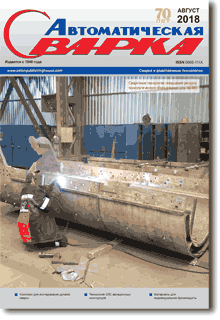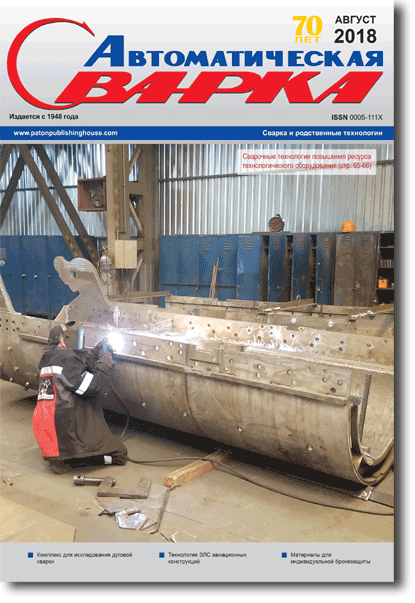| 2018 №08 (06) |
DOI of Article 10.15407/as2018.08.07 |
2018 №08 (08) |

Avtomaticheskaya Svarka (Automatic Welding), #8, 2018, pp. 45-50
Materials for individual armor protection (Review)
A.A. Babinets1, I.A. Ryabtsev1, A.I. Panfilov2
1E.O. Paton Electric Welding Institute of the NAS of Ukraine, 11 Kazimir Malevich Str., 03150, Kyiv, Ukraine. E-mail: office@paton.kiev.ua
2OJSC «Steel Wrok», Kryvyi Rih, Ukraine. E-mail: a.panfilov@steel-work.net
Abstract
The paper analyzes the available literature data on the properties of different materials currently used in the means of individual armor protection and the methods for improving their bulletproof and other service properties are evaluated. It is shown that at the present time to create the means of individual armor protection, a variety of materials are used: fabric aramid or polyethylene fibers, metal plates based on steels, titanium, aluminum and their alloys, as well as ceramics based on boron and silicon carbides, etc. The main advantages and disadvantages of these armored materials are shown. On the basis of literary data, it was established that for the 3-5 class of protection, the armored plates of structural alloyed steels were widely used. To minimize the disadvantages inherent in steel armored plates, it is necessary to use bimetallic compositions with alternating hard and soft layers, produced, among others, by welding or surfacing methods. 20 Ref., 4 Tab., 3 Fig.
Key words: individual armor protection, classes of protection, properties of armored materials, bulletproof, armor steels, composites, multilayer materials
References
1. Kobylkin, I.F., Selivanov, I.F. (2014) Materials and structure of light armour protection. Moscow, N.E. Bauman NSTU [in Russian].
2. Gladyshev, S.A., Grigoryan, V.A. (2010) Armoured steels. Moscow, Interment Engineering [in Russian].
3. Grigoryan, V.A., Kobylkin, I.F., Marinin, V.M., Chistyakov, E.N. (2008) Materials and protective structures for local and individual armouring. Moscow, RadioSoft [in Russian].
4. Anastasiadi, G.P., Silnikov, M.V. (2004) Operating capability of armour materials. St.-Petersburg, Asterion [in Russian].
5. Bajdak, V.I., Blinov, O.F., Znakhurko, V.A. et al. (2003) Concept basics for development of means of individual armour protection. Moscow, Armouring. Politics. Conversion [in Russian].
6. Manzhura, S.A. (2017) Selection of armoured plate materials for individual means of armour protection of law enforcement forces. Systemy Ozbroennya i Vijskova Tekhnika, 2, 89–93 [in Ukrainian].
7. Bolotov, M.G., Ganeev, T.R., Novomlynets, O.O., Prybytko, I.O. (2015) New trends of application of titanium aluminides. Tekhnichni Nauky ta Tekhnologii, 2, 51–55 [in Ukrainian].
8. Novikov, V.A. (2015) Flak jacket: Modern materials and their properties. In: Proc. of Int. Sci.-Techn. Conf. of Young Scientists of V.G. Shukhov BSTU (1–30 May, Belgorod), 1443–1446.
9. Gorbunov, I.M., Kharchenko, E.F., Aniskovich, V.A. (2006) Analysis on scientific and technical level of development of modern armour protection means in Russia and abroad. Oboronny Compleks — Nauchno-Tekhnicheskomu Progressu Rossii, 4, 32–35 [in Russian].
10. (2002) DSTU 4103–2002: Means of individual protection, bulletproof vests. General specifications [in Ukrainian].
11. Zagoryansky, V.G. (2015) Substantiation for application of steel-aluminium bimetal on calculation criteria of bulletproof armour. Visnyk NTUU KPI. Seriya: Mashynobuduvannya, 3, 37–41 [in Ukrainian].
12. Guskov, A.V., Milevsky, K.A., Pavlova, O.V. (2014) bulletproof vests with ceramic armour elements of honeycomb structure. Evrazijsky Soyuz Uchyonykh, 8–8, 45–46 [in Russian].
13. Mylnikov, V.V., Abrosimov, A.A., Romanov, I.D., Romanov, A.D. (2014) Analysis of materials and their properties, applied for means of individual armour protection. Uspekhy Sovremennogo Estestvoznaniya, 9–2, 143–147 [in Russian].
14. Chernyshov, E.A., Mylnikov, V.V., Mylnikova, M.V., Romanov, A.D. et al. (2014) Development of metal-ceramic elements of ballistic protection using aluminium-based ceramics. Sovremennye Naukoyomkie Tekhnologii, 4, 97–100 [in Russian].
15. Aleksentseva, S.E., Zakharov, I.V. (2011) Effect of shockproof properties of alloys on bulletproofness. Vestnik Samar. STU. Seriya: Tekhnicheskie Nauki, 4, 88–95 [in Russian].
16. Radonjic, V.M., Jovanovic, D.M., Zivanovic, G.Z., Resimic, B.V. (2014) Ballistic characteristics improving and maintenance of protective ballistic vests. Vojnotehnicki glasnik, 62 (Is. 4), 89-103. DOI: 10.5937/vojtehg62-4992. https://doi.org/10.5937/vojtehg62-4992
17. Kryukov, D.B., Kozlov, D.B. (2016) Perspectives of application of metal composite materials for development of armouring of new generation. Vestnik Penzenskogo Gos. Unta, 2, 103–108 [in Russian].
18. Dragobetsky, V.V., Shapoval, A.A., Zagoryansky, V.G. (2015) Development of elements of individual protection means of new generation based on laminated metallic compositions. Vuzov, Chyorn. Metallurgiya, 58, 1, 44–48 [in Russian].
19. Morka, A., Jackowska, B. (2010) Ballistic resistance of the carbon nanotube fibres reinforced composites — numerical study. Mater. Sci., 50(4), 1244–1249. DOI:10.1016/j. commatsci.2010.03.046.
20. Kurkov, S.N., Kukanov, S.A., Zajtsev, Yu.M. (2016) Application of nanostructured materials in protective compositions of individual armour means. Tulskogo Gos. Un-ta. Tekhnicheskie Nauki, 3, 53–59 [in Russian].
Received: 19.06.2018
Published: 19.07.2018.
The cost of subscription/purchase order journals or individual articles
| Journal/Currency | Annual Set | 1 issue printed |
1 issue |
one article |
| TPWJ/USD | 384 $ | 32 $ | 26 $ | 13 $ |
| TPWJ/EUR | 348 € | 29 € | 24 € | 12 € |
| TPWJ/UAH | 7200 UAH | 600 UAH | 600 UAH | 280 UAH |
| AS/UAH | 1800 UAH | 300 UAH | 300 UAH | 150 UAH |
| AS/USD | 192 $ | 32 $ | 26 $ | 13 $ |
| AS/EUR | 180 € | 30 € | 25 € | 12 € |
| SEM/UAH | 1200 UAH | 300 UAH | 300 UAH | 150 UAH |
| SEM/USD | 128 $ | 32 $ | 26 $ | 13 $ |
| SEM/EUR | 120 € | 30 € | 25 € | 12 € |
| TDNK/UAH | 1200 UAH | 300 UAH | 300 UAH | 150 UAH |
| TDNK/USD | 128 $ | 32 $ | 26 $ | 13 $ |
| TDNK/EUR | 120 € | 30 € | 25 € | 15 € |
AS = «Automatic Welding» - 6 issues per year;
TPWJ = «PATON WELDING JOURNAL» - 12 issues per year;
SEM = «Electrometallurgy Today» - 4 issues per year;
TDNK = «Technical Diagnostics and Non-Destructive Testing» - 4 issues per year.





